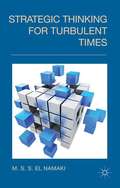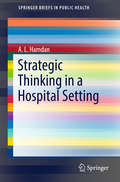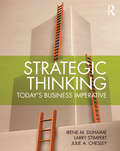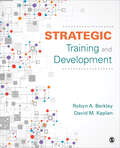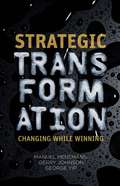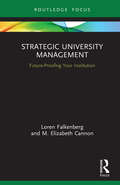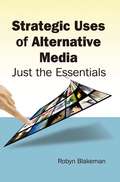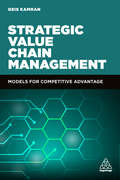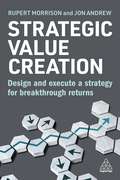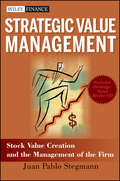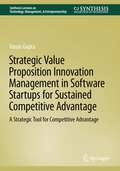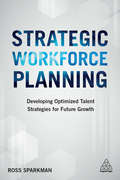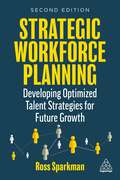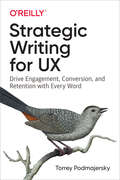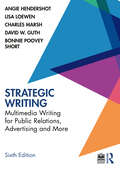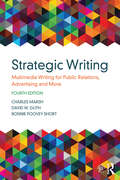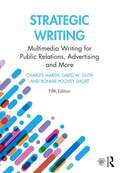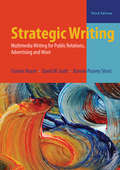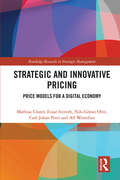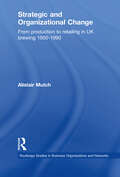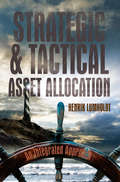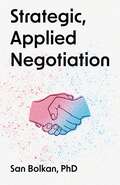- Table View
- List View
Strategic Thinking for Turbulent Times
by M. S. S. el NamakiStrategic Thinking for Turbulent Times is a conceptual and operational guide to the process of business strategy formulation within a turbulence driven economic and business environment. This book features pioneering work on the process of strategic thinking after the dramatic shift in the fundamental premises of strategic management.
Strategic Thinking in a Hospital Setting
by A. L. HamdanTranslating the realities of healthcare reform and healthcare costs into competitive hospital practice is the goal of this accessible, jargon-free guide. Taking its cue from Michael Porter’s highly-regarded business strategies, it offers a sound framework for hospitals looking to develop efficient, patient-centered service delivery, identifying keys to clinical, administrative, and marketing success. The book organizes business and clinical priorities where they intersect so that physicians throughout healthcare systems can understand their role in building and sustaining innovation, and leverage their strengths and system resources toward meeting patient needs. In addition, chapters review eight core strategic tools, describe possibilities for their implementation, and provide in-depth findings on Porter’s methods as used in a diverse group of hospitals across Lebanon. Included in the coverage: · Porter’s strategies in health care: cost leadership versus differentiation strategy · Sources of competitive advantage · How to prepare an organization for innovation · Strategic framework in a hospital setting · Application of Porter’s strategies in Lebanese hospitals · Correlation between type of strategy and performanceA well-designed blueprint for enhancing patient satisfaction and system cost-effectiveness, Strategic Thinking in a Hospital Setting is aimed at both frontline physicians in practice and those assuming administrative positions in healthcare facilities and in hospital settings in particular.
Strategic Thinking: Today’s Business Imperative
by Irene M. Duhaime Larry Stimpert Julie ChesleyThere are many strategy books available in the marketplace for today’s student or business professional; most of them view strategy from the 10,000 foot level, while Strategic Thinking looks at this important business topic through a different lens. Written from the perspective of a manager, this book builds on theories of managerial and organizational cognition that have had a powerful influence on many business fields over the last two decades. As other books on business policy and strategy cover a broad range of topics, models, frameworks, and theories, the unique feature of this book is that it covers all this, but also focuses on how managers of business firms understand their business environments, assess and marshal their firms’ resources, and strive for advantage in the competitive marketplace. It examines the economic, structural, and managerial explanations for firm performance. Offering professors and business people who are intrigued by the ideas introduced in Peter Senge’s books ways to apply those ideas and principles in the classroom and in the companies in which they work, the book puts managers front and center.
Strategic Training and Development
by David M. Kaplan Robyn Ann BerkleyPeople are the most important resource for today′s organizations. Organizations must invest in their employees to sustain a competitive advantage and achieve their strategic objectives. Strategic Training and Development translates theory and research into best practices for improving employee knowledge, skills, and behaviors in the workplace. Authors Robyn A. Berkley and David M. Kaplan take a holistic and experiential approach, providing ample practice opportunities for students. A strong focus on technology, ethics, legal issues, diversity and inclusion, and succession helps prepare students to succeed in today’s business environment.
Strategic Training and Development
by David M. Kaplan Robyn Ann BerkleyPeople are the most important resource for today′s organizations. Organizations must invest in their employees to sustain a competitive advantage and achieve their strategic objectives. Strategic Training and Development translates theory and research into best practices for improving employee knowledge, skills, and behaviors in the workplace. Authors Robyn A. Berkley and David M. Kaplan take a holistic and experiential approach, providing ample practice opportunities for students. A strong focus on technology, ethics, legal issues, diversity and inclusion, and succession helps prepare students to succeed in today’s business environment.
Strategic Transformation
by Gerry Johnson Manuel Hensmans George YipVery few companies are successful in undertaking strategic transformation while maintaining long term superior financial performance. This book, by leading strategy experts, draws upon extensive interviews with business leaders and insights from companies faced with this challenge.
Strategic Treaty Management
by Thomas F. McinerneyWhile little recognized in international law scholarship, multilateral treaties in diverse fields have begun to apply strategic management techniques to make them more effective and responsive. This examination of those practices and their interplay with associated international organizations considers the application of strategic management across treaties' planning, financing, implementation, and evaluation activities. The study leads to a new appreciation of the intricacies of multilateral treaty activities and a better understanding of their operations within complex webs of networked international institutions. In considering different approaches to steering treaties through this dispersed global governance landscape, Thomas F. McInerney draws on current strategic management literature to explore the utility of nonlinear, emergent models of strategy and gain insights from strategy as practice research. While recognizing strategic management's potential value in facilitating more flexible applications of multilateral agreements, he also emphasizes the need to maintain their normativity as international legal obligations.
Strategic University Management: Future Proofing Your Institution (Routledge Focus on Business and Management)
by Loren Falkenberg M. Elizabeth CannonUniversities are being buffeted by multiple disruptive trends, including increased competition for both funding and students, as well as from new institutions that are nimbler and more responsive to the external environment. To survive this reality, university leaders must engage in effective strategic planning that cascades from the president or vice-chancellor’s office to individual faculty and staff. Outcomes of an effective institutional strategy are the alignment of resource allocation with strategic goals, and the facilitation of clear and transparent decision-making for new program development, research capacity growth, and infrastructure investment. With increasing expectations for university leaders to engage in strategic planning, Strategic University Management: Future Proofing Your Institution provides a practical framework for managing the process and delivering results. This book illustrates that the inherent weaving of strategic planning and organizational culture through engaged consultation facilitates a culture of responsiveness, rather than complacency. Providing an in depth overview of the value strategy can create in universities, it provides a framework for initiating, implementing and assessing strategic planning in a university setting that will make it valuable to researchers, academics, university leaders, and students in the fields of strategic planning, organizational studies, leadership, and higher education management.
Strategic Uses of Alternative Media: Just the Essentials
by Robyn BlakemenDesigned for students and practitioners in the fields of organizational behavior and human resource training and development, this book examines improving organizational communication. Terrence Gargiulo shows how the use of storytelling is the key to effective communication and learning.
Strategic Value Chain Management: Models for Competitive Advantage
by Dr Qeis KamranA supply chain is the process of all parties involved in fulfilling a customer request, while a value chain is a set of interrelated activities a company uses to create value and a competitive advantage. In Strategic Value Chain Management the authors bring together a variety of disciplines, showing how to move from traditional supply chain management to value chain management. Research from the (ISM) International School of Management, Germany, originating from a network of companies in a range of sectors, is integrated with case studies to demonstrate particular concepts.Strategic Value Chain Management brings together theory and practice and presents tangible ways of creating competitiveness in a changing world through the use of effective models and frameworks. Challenging the traditional Porters Five Forces Model, the authors introduce the important academic disciplines of cybernetics and systems sciences as essential drivers of strategy within the supply chain, supported by case studies illustrating their implementation.
Strategic Value Creation: Design and Execute a Strategy for Breakthrough Returns
by Rupert Morrison Jon AndrewStrategic Value Creation shows how senior business leaders can design and execute a data-driven strategy for their organizations to ensure that value creation is focused on the customer segments most integral to business success.Value creation underpins any successful business and businesses that fail to create unique value for their customers will struggle to survive. This book demonstrates how to recognize when strategy, thinking and actions are flawed, how to correct these and how to devise and implement an effective strategy that unlocks the power of value creation. It provides the practical tools necessary to put strategic theories and frameworks into practice and explains the data needed at every step.Strategic Value Creation shares the powerful 4Ds framework for strategy execution: Diagnose today, Design tomorrow, Draw the plan and Deliver with data. This framework outlines how to use data for diagnosis, analyse value factors for customer segmentation, determine the value factors their customers value the most and ensure differentiation from competitors. It also covers how to track and measure performance against stated objectives and risks, improve board packs, board back commentary and board meeting effectiveness, and capture and categorize actions, ensuring they are managed effectively.
Strategic Value Management
by Stegmann Juan PabloInnovative strategic management solutions for today's market Strategic Value Management addresses common problems among business managers and other professionals involved in thinking about developing and managing organizations. In it, author Juan Pablo Stegmann integrates all strategic management and business strategy into an innovative standard that introduces key metrics to strategic management and stock value creation. He argues that most complex business issues can be reduced to the three dimensions of stock value creation-profits, sales growth, and capital-that are linked to three critical strategic management decisions-competition, innovation, and resources. His new approach indicates that every strategy has a clear dollar metric, which can measure its consequences of the strategies in terms of stock value. Competitive and growth strategies are analyzed along with economic, financial, dynamic, and contingent approaches Includes a companion CD-ROM, which contains Stegmann's proven model for strategic management and stock value creation Ethical consequences of strategic decisions are introduced-showing how ethics are linked to long-term stock value creation Explains the roots of the current financial crisis by examining the link between the financial world and strategic management, and proposes possible solutions For any looking to enhance their understanding of this discipline, Strategic Value Management offers a new conceptual model for thinking about business strategy and its link to stock value creation.
Strategic Value Proposition Innovation Management in Software Startups for Sustained Competitive Advantage: A Strategic Tool for Competitive Advantage (Synthesis Lectures on Technology, Management, & Entrepreneurship)
by Varun GuptaThis book aims to increase the success rates of startups by focusing on value proposition innovation, which is propelled by the involvement of potential consumers as well as other resources such as freelancers and strategic relationships with academia. The author shows how startups who are resource constrained can invest efforts exploring the potential market of their products. The author also explores how global markets can be beneficial for a startup’s success, while showing the workarounds in hard-to-access markets. The book investigates gaining knowledge shared by freelancers, customers, and academia, whose involvement can be crucial in supporting value proposition innovation activities such as ideas generation, implementation, and commercialization. Combined, the author leads readers to discover their ability to foster value proposition innovations that result into long term competitive advantage in a highly fluctuating business environment.
Strategic Workforce Planning: Developing Optimized Talent Strategies for Future Growth
by Ross SparkmanStrategic Workforce Planning is a practical guide to effectively assessing, managing and preparing for current and future workforce requirements. It demystifies the often complex and seemingly technical world of strategic workforce planning to explain what it is, why it's necessary and most importantly, how to do it. Packed full of advice and real-world examples, Strategic Workforce Planning is a playbook for workforce planning from beginning to end. It will enable HR professionals to answer core business questions including how do I analyze future hiring demand? How do I assess what skills will be required in the future? How should I prioritize investments like training and development? How do I assess the supply of talent around the world? How do I identify the business drivers that impact workforce demand? It also covers the impact of artificial intelligence (AI), automation and machine learning on the global workforce and how to deal with these implications. Whether you're a start-up, small business or a large corporate, this book will show you how to align people strategy with company strategy to ensure your organization maintains its competitive advantage.
Strategic Workforce Planning: Developing Optimized Talent Strategies for Future Growth
by Ross SparkmanStrategic workforce planning can often be complex and technical, so how can organizations demystify the processes to effectively prepare for current and future workforce requirements? Strategic Workforce Planning is a comprehensive guide that explains what it is, why it's necessary and most importantly, how to do it. It enables HR professionals to understand and resolve core business matters, from analysing future hiring demand to prioritizing investments like training and development. It also covers how to manage the impact of artificial intelligence (AI), automation and machine learning on the global workforce. This fully updated second edition features a new chapter on remote working strategies and operational workforce planning, as well as new and updated case studies and material on workforce planning in a downturn and for Diversity and Inclusion. Providing fresh perspectives alongside the fundamental theory, Strategic Workforce Planning is essential reading for practitioners of all levels of experience looking to align people strategy with company strategy and maintain competitive advantage.
Strategic Writing for UX: Drive Engagement, Conversion, and Retention with Every Word
by Torrey PodmajerskyWhen you depend on users to perform specific actions—like buying tickets, playing a game, or riding public transit—well-placed words are most effective. But how do you choose the right words? And how do you know if they work? With this practical book, you’ll learn how to write strategically for UX, using tools to build foundational pieces for UI text and UX voice strategy.UX content strategist Torrey Podmajersky provides strategies for converting, engaging, supporting, and re-attracting users. You’ll use frameworks and patterns for content, methods to measure the content’s effectiveness, and processes to create the collaboration necessary for success. You’ll also structure your voice throughout so that the brand is easily recognizable to its audience.Learn how UX content works with the software development lifecycleUse a framework to align the UX content with product principlesExplore content-first design to root UX text in conversationLearn how UX text patterns work with different voicesProduce text that’s purposeful, concise, conversational, and clear
Strategic Writing: Multimedia Writing for Public Relations, Advertising and More
by Charles Marsh David W. Guth Bonnie Poovey Short Angie Hendershot Lisa LoewenFeaturing examples of strategic writing throughout the book, this practical, multidisciplinary text takes students through the fundamental concepts, genres, and techniques of writing for strategic communicators to connect with their publics. The book contains concise instructions for writing the key multimedia documents in strategic communication, each with an example in the text. Short, practice-oriented chapters each cover a key theme, principle or writing topic. This sixth edition features: new and more diverse examples; additional references on legal and ethical guidance, technical tools and other resources used by practicing professionals; a new Audience Persona chapter; and incorporation of digital trends, such as increased use of images, video and user-generated content as well as evolutions in mobile marketing and other emerging platforms. Strategic Writing, Sixth Edition is an essential textbook for undergraduate courses in public relations, advertising and strategic communication writing, particularly those that take a multidisciplinary approach. Online resources are also included to support instructors and students. Faculty will find sample assignments with rubrics and lecture slides. Students will find practice quizzes for each section; nine-step strategic writing process guidance with helpful links for each step; and examples, templates and online articles demonstrating strategic writing in practice. Please visit www.routledge.com/cw/hendershot.
Strategic Writing: Multimedia Writing for Public Relations, Advertising and More
by Charles Marsh David W. Guth Bonnie Poovey ShortIn its fourth edition, Strategic Writing emphasizes the goal-oriented mission of high-quality public relations and media writing with clear, concise instructions for more than 40 types of documents. This multidisciplinary text covers writing for public relations, advertising, sales and marketing, and business communication. In addition, it includes concise chapters on topics such as diversity, ethics and the legal aspects of strategic writing. Featuring a spiral binding, examples for each document and a user-friendly "recipe" approach, Strategic Writing is ideal for undergraduate PR or advertising writing classes that take an interdisciplinary approach. This new edition devotes new attention throughout to social media and writing in the digital realm, and features new and updated online resources for students and instructors.
Strategic Writing: Multimedia Writing for Public Relations, Advertising and More
by Charles Marsh David W. Guth Bonnie Poovey ShortThis practical, multidisciplinary text teaches high-quality public relations and media writing with clear, concise instructions for more than 40 types of documents. <p><p>Strategic Writing takes a reader-friendly "recipe" approach to writing in public relations, advertising, sales and marketing, and other business communication contexts, illustrated with examples of each type of document. With concise chapters on topics such as ethical and legal aspects of strategic writing, including diversity and inclusion, this thoroughly updated fifth edition also includes additional document samples and coverage of writing for various social media platforms. Packed with pedagogical resources, Strategic Writing offers instructors a complete, ready-to-use course. <p><p>It is an essential and adaptable textbook for undergraduate courses in public relations, advertising and strategic communication writing, particularly those that take a multidisciplinary and multimedia approach. <p><p>Strategic Writing is ideally suited for online courses. In addition to syllabi for both online and traditional courses, the instructor’s manual includes Tips for Teaching Strategic Writing Online. Those tips include easy guidelines for converting the book’s PowerPoint slides to videos with voiceovers for online lectures. The book’s recipe-with-examples approach enhances student self-instruction, particularly when combined with the companion website’s sample assignments and grading rubrics for every document.
Strategic Writing: Multimedia Writing for Public Relations, Advertising, and More
by Charles Marsh David W. Guth Bonnie Poovey ShortIn its third edition, Strategic Writing emphasizes the strategic, goal-oriented mission of high-quality media and public relations writing with clear, concise instructions for more than 40 types of documents. This multidisciplinary text covers writing for public relations, advertising, sales and marketing, and business communication. Featuring a spiral binding, numerous examples and a user-friendly "recipe" approach, Strategic Writing is ideal for public relations writing classes that include documents from other disciplines.
Strategic and Innovative Pricing: Price Models for a Digital Economy (Routledge Research in Strategic Management)
by Einar Iveroth Nils-Göran Olve Carl-Johan Petri Mathias Cöster Alf WesteliusThis book provides a concrete guide on how to execute strategic pricing to excel in an increasingly dynamic and digitised business environment, while developing and deepening relations with contract partners. The secret lies in crafting innovative price models that reward joint value creation in accordance with the business model, rather than engaging in confrontative zero-sum pricing reasoning. Strategic and Innovative Pricing: Price Models for a Digital Economy provides hands-on tools that are applied on three interconnected levels of analysis. It illustrates how to explore the business ecology to understand its dynamics and how digitisation enables it to prosper and demonstrates how to construct a viable business model that enables an organisation to navigate in its vibrant ecology. Finally, and most importantly, it shows how to use innovative price models to realize and monetise the business model and its value offering, making the organisation and its partnerships sustainable. Models pertaining to the three levels of analyses are applied in rich case studies and examples from different countries, and the book includes guidelines on how to use them. Special attention is paid to digitisation as an underlying theme, making this book of interest to researchers, academics, and students in the fields of strategic management and technology & innovation management.
Strategic and Organizational Change: From Production to Retailing in UK Brewing 1950-1990 (Routledge Studies in Business Organizations and Networks #Vol. 33)
by Alistair MutchThe brewing industry, through its network of public houses, has a profound impact on the lives of much of the population of United Kingdom. Exploring the shaping of this industry in the years from 1950-1990, this book shows how it has moved from being largely concerned with the technical issues of production to being a key part of the retail industries. Drawing from theoretical traditions such as critical realism and new institutionalism, Strategic and Organizational Change demonstrates the considerable differences between major companies in the industry and the ways in which they have adopted a retailing approach. At the heart of the book is an exploration of the relationship between managerial choice and the structural constraints and opportunities in which that choice was exercised. Providing a new model of how history can inform the analysis of organizational strategy, the book draws on extensive archival material and adopts a far more historical approach than previous accounts of the area. Above all, Alistair Mutch presents a fascinating story of change in an industry which is taken for granted, but whose actions affect, for good or ill, the lives of millions.
Strategic and Sustainable Management of Workplace Facilities
by Yewande Adewunmi-AbolarinwaThis book introduces the reader to contemporary issues in the management of facilities in the African context and includes case studies from across the continent and internationally. It consolidates theory and practical information useful for managers and researchers across Africa and other developing countries. It covers a cross section of the key elements of facilities management, including customer relations management, emergency preparedness, development of a facilities strategy, sustainable buildings management, and management of intelligent buildings in developing countries.The book has been developed from a combination of degree level and professional course materials and academic resources and is therefore suitable for use by students on undergraduate and postgraduate degree programmes, professional short courses, and for practicing facilities managers and members of IFMA, SAFMA, IWFM, HEFMA, RICS, Association of Facilities Management Practitioners of Nigeria, Egypt Facility Management Association, Botswana Facilities Management Association, and the Africa Facilities Management Association as a key reference. This book is key reading for anyone: Studying for a degree in Facilities Management, Real Estate, Estate Management, Workplace Management, or Surveying Wanting to be more strategic in their facilities management and operations Transitioning into a facilities management role from another profession Benchmarking and analysing the performance of their built assets Training themselves or their staff in emerging areas such as workplace productivity, sustainability, and intelligent buildings systems Interested in researching emerging areas of facilities management in developing countries This is the essential guide to the growing field of facilities management in some of the world’s fastest developing countries.
Strategic and Tactical Asset Allocation: An Integrated Approach
by Henrik LumholdtThis book covers each step in the asset allocation process, addressing as many of the relevant questions as possible along the way. How can we formulate expectations about long-term returns? How relevant are valuations? What are the challenges to optimizing the portfolio? Can factor investing add value and, if so, how can it be implemented? Which are the key performance drivers for each asset class, and what determines how they are correlated? How can we apply insights about the business cycle to tactical asset allocation? The book is aimed at finance professionals and others looking for a coherent framework for decision-making in asset allocation, both at the strategic and tactical level. It stresses analysis rather than pre-conceived ideas about investments, and it draws on both empirical research and practical experience to give the reader as strong a background as possible.
Strategic, Applied Negotiation
by Phd San BolkanIn Strategic, Applied Negotiation, San Bolkan takes an evidence-based approach to helping readers improve their negotiation skills while providing clear and practical advice. He dedicates chapters to topics including Power in Negotiation, Opening Offers, Making Concessions, and Handling Questionable Tactics to give readers a comprehensive look at bargaining with others.
